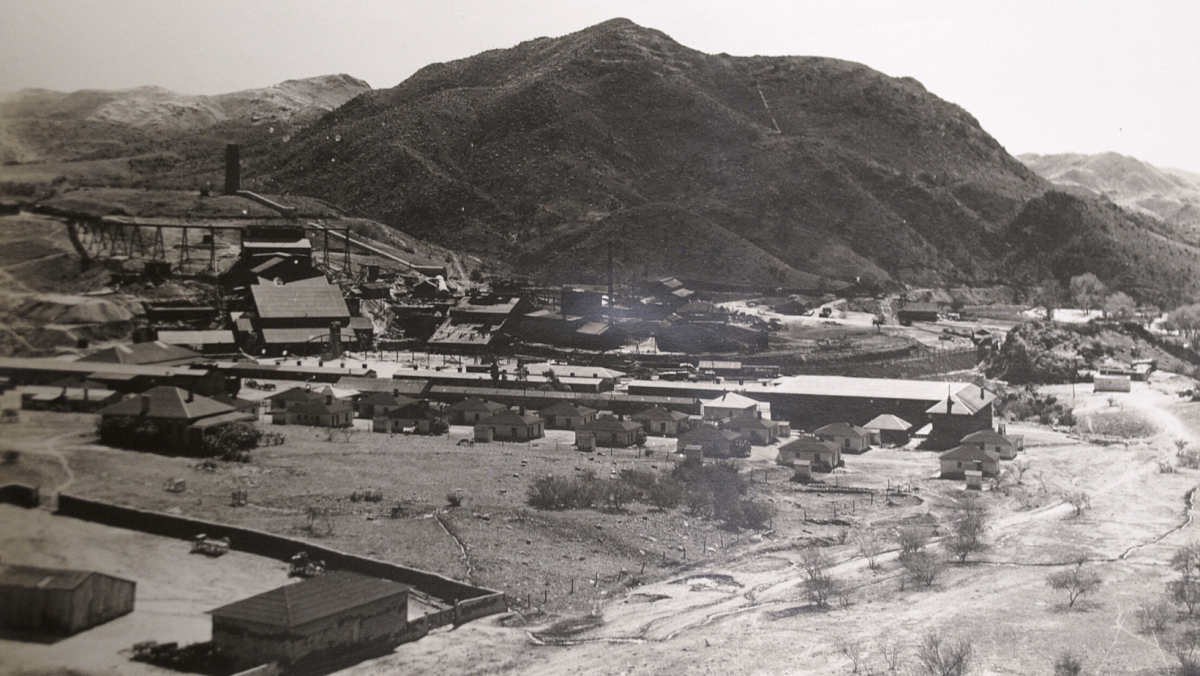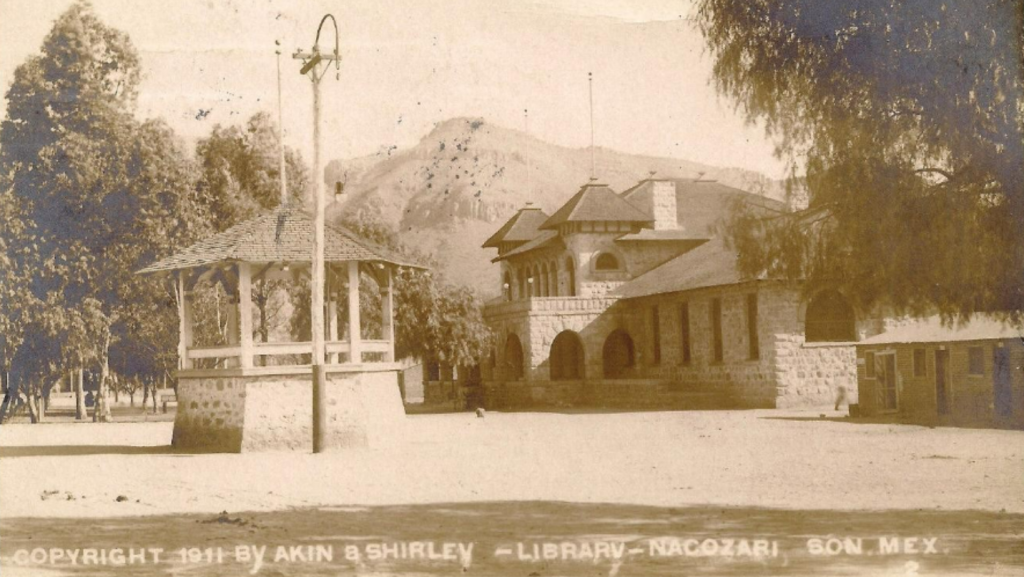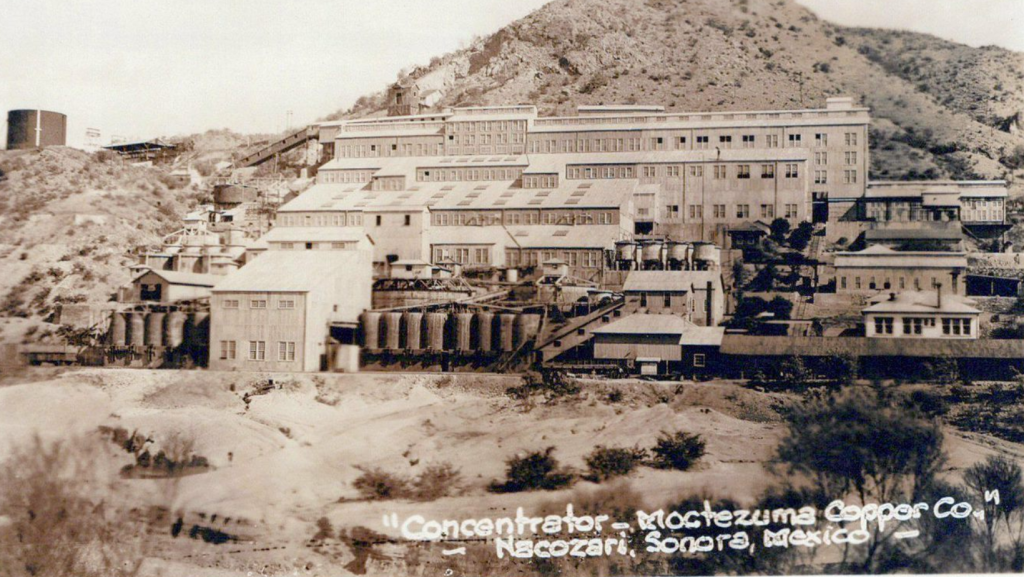
The Kingdom of Nacozari—An Overview of a Booming Mining Town
14 de noviembre de 2022
Unknown Author (1907)
Full description of the magnificent property presided over by J. S. Douglas, whose power is almost that of a monarch in Nacozari.
The mining camp, as it is called, lies seventy-seven and one-half miles or 124 kilometers almost due south from the city of Douglas. It is reached over the Nacozari railroad. The interested passenger leaves the city of Douglas about 2 o’clock in the afternoon and rides til 6:15 pm., when he arrives at Nacozari, usually surprised and delighted.
The town contains about 2,000 inhabitants, of which, perhaps, 500 are gringos, as the Mexicans call Americans. It is situated on a rolling mesa about a half mile in diameter and is substantially built with neat tidy appearing cottages and houses, the homes of the married population. The home of Mr. J. S. Douglas, the power that moves all things in this section is a broad, low, imposing building, overlooking the city. It is surrounded with verandas and looks cool and comfortable. There are other several fine buildings including the Nacozari hotel, the Moctezuma Copper Company’s store, the hospital, and the unmarried men’s rooming apartments. All of these buildings are substantially built with lumber, brick, adobe, and stone. The lumber comes from the United States.
The mountains about the city give to it a romantic and picturesque appearance, not unlike many places in the old world. The mountains are not far away and loom up grandly in the rays of the morning sun. Mount Nacozari, a trifle southwest of the town, is the highest peak between and city and the United States boundary, excepting Perico mountain, near Cos.
The city is absolutely owned and controlled, body, soul, and breeches, by “the company”, as most of the gringos familiarly call the Moctezuma Copper Company. The concern is owned by the Phelps Dodge Company of New York. Mr. J. S. Douglas is the general manager for this company, and in Nacozari, is an absolute monarch. His word is law and none dispute. Not like his namesake, the old Scottish earl, he is just. His brain works when others sleep, and he has made Nacozari the cleanest and most sanitary of the large mining camps in the Mexican Republic. He has written “success” on the operations of the great concentrating copper plant here. It was his genius that made the Nacozari railroad a safe and paying proposition; he is universally respected by every man, woman, and child in Nacozari and vicinity.
Not a foot of land can be bought by anyone in Nacozari. It all belongs to the Moctezuma Copper Company. Every building is erected by it and they are rented to employees at a very reasonable price. There is no skin game played and there is no gougeing. It is always a square deal and the people seem to be satisfied and contented. The hotel, the store, rooming house, and hospital are all under the control of the company.


Through the town flows the Moctezuma river, a babbling, meagerly-watered stream in summertime, on its way to join the Yaqui river away to the south. It is spanned by a long iron rail bridge. Across the stream, a few minutes’ walk from the hotel is the great reduction plant of the Moctezuma Copper Company. Day and night for 365 days in a year, this plant is in operation and employs, with the mines six miles away, more than one thousand men. The mammoth engines in the big structural steel powerhouse furnish the power that crushes to a flour-like paste seven hundred tons of copper ore every twenty-four hours. The gang of waste is dumped into the Moctezuma river and carried away by the water when the stream is a flood. The concentrates (the part of the crushed ore containing values) are all saved by machinery and sent to the great smelter at Douglas.
Two hundred and fifty thousand tons of ore produced annually by the Phelps-Dodge mines
This mighty mass of ore, reaching the enormous amount of 255,500 tons annually, is brought from the mines of the company, six miles away, over a narrow gauge steam railroad in dump cars. These cars move in winding route down the mountain and crawl out on an elevated tramway over great bins capable of holding 3,000 tons each; here they are dumped and the train returns to the big, black tunnel in the hills of another grist of the red metal rock.
From the great ore bins, the rock goes into giant-like crushers and is ground to pieces and made smaller. It again drops down into another crusher and made still smaller; then down again it goes only to meet the mighty iron teeth of another machine, and so it keeps moving downward through crushers until it becomes as fine as flour. Somewhere near the top of the plant a stream of water is turned into the crushers and sweeps the pulverized rock down through many artificial channels to the vanners where the last act of concentrating is done. There are forty-eight of these vanners, each about six feet wide and made of rubber-coated canvas. They are all in a line, nearly flat and constantly shaking like a man with the Michigan ague. The heavy metallic parts of the ore, fine as flour, go over the end of a vanner and settle in prepared receptacles and the lighter parts, called gang, float off in the thin stream of water that carries them.
One hundred and twenty-five tons of concentrates are saved daily and sent to Douglas to be smelted. The building that contains the machinery to run this plant is nearly one hundred feet high from top to base, three hundred feet long, and twenty-five feet wide. More than one hundred and ninety tons of belting are used on the thousand-and-one wheels great and small. The concentrating plant is under the able direction of Mr. A. L. Berner.
But the management and direction of the entire business of the plant, from end to end, is under the charge of Mr. J. S. Williams, Jr., a comparatively young man. He stands next in power to Mr. Douglas and is a quiet bright-eyed man and a great general in his business. He is even alert, prompt, and decisive.
The mines, six miles distant, are under the direction of Mr. George Kingdon, an expert mining engineer. His assistant is Mr. T. M. Stanton, also a mining engineer of ability. Both gentlemen are resourceful and possess ability of the highest order. Mr. Jas Conway is chief engineer and a mighty good man. In the powerhouse, Mr. Colgate Fales is chief electrician and does his work well. Mr. James W. Goodman is the master mechanic and his skill is often tested in the many puzzling propositions that come to him. Very soon, however, the present reduction plant of the Moctezuma Copper Company on its present site will be a thing of the past.
In the main offices of the company may be seen daily a square-jawed, keen-eyed man, somewhat above medium stature, with countenance and head that indicates the highest order of intelligence. This gentleman is Mr. H. Kenyon Burch, and though scarce thirty-two years of age, he has accomplished more than some of our best men do in a lifetime. It was his intellect that, to a great extent, planned the present plant, and the mountain, perhaps a quarter of a new concentrating plant soon to be erected in a geosynclinal or saddle of the mountain, perhaps a quarter of a mile from the present site. This new plant will be larger, contain more machinery, and be as modern as human skill can make it. Work on grading for the new plant and railroad to it has already commenced.
Many new improvements are in store for Nacozari; ground has been broken for a new schoolhouse to cost no less than $20,000; work has been commenced on a new library building, and Mr. Douglas intends to make it one that will be classed with the best. It will be larger than the Y.M.C.A. building in Douglas and contain a large reading room and books of all sorts, bathrooms, billiard tables, etc. The basement, in part, will be occupied by the federal post and telegraph offices. Many other progressive projects are being considered for the city or, as the people choose to call it, the mining camp.
Mr. Douglas and his able corps of assistants have been the only ones who have ever been able to make the Pilares mines pay. These mines are located about six miles southeasterly from Nacozari and the low-grade copper ore from them feeds the mighty iron maws of the concentrating plant.
The hotel accommodations are first-class. The Nacozari hotel is under the management of Mr. Robert J. Wilson, also a young man and as genial a boniface as ever came down the pike. His assistant is Mr. W. J. Woolverton, also as genial as the flowers of May time. The guests who stop at this place are sure to be pleased, and why not? They always get plenty to eat, good rooms, and good beds.
Wood and water are plenty; health and contentment prevail; peace and good order reign and thrift and abundance exist in the miniature kingdom of Nacozari.
On the first of January, 1907, without the asking, the Moctezuma Copper Company raised the wages of all its employees and more substantial Christmas presents on the preceding Christmas Eve.
One mind rules this place—the mind of James S. Douglas; he is the king of Nacozari and his laws seem to be just and his authority respected.
Published on The Bisbee Daily Review
Bisbee, Arizona, January 10, 1907
Cover Photo: Nacozari 1908 © McClintock Collection, Phoenix Public Library
© All Rights Reserved
